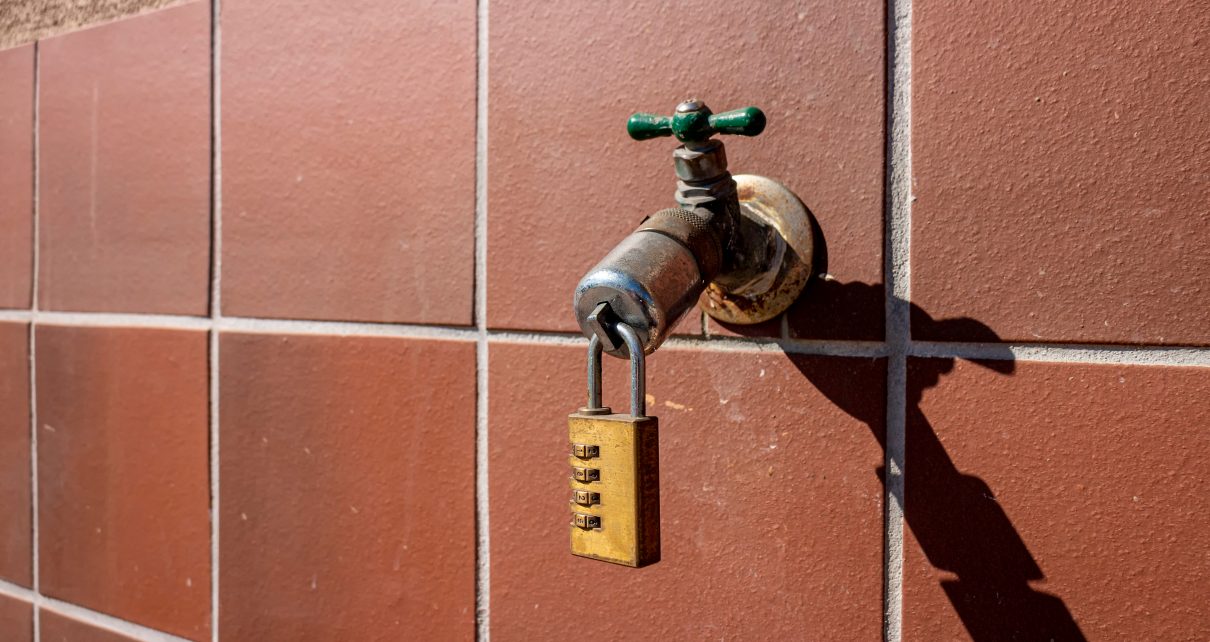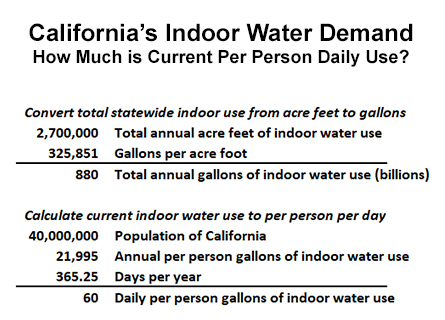
Water rationing. (Photo: Shutterstock, F Armstrong Photography)
The Abundance Choice, Part 2: The Problems With Indoor Water Rationing
Enforcing these mandates will not have a significant effect on overall water consumption in California
By Edward Ring, May 12, 2022 2:45 am
Perhaps the biggest example of misguided water policy in California are the escalating restrictions on indoor water consumption. As will be seen, the savings these restrictions amount to are trivial in the context of California’s total water consumption, yet are imposed at tremendous cost both in quality of life and in the required economic sacrifice. Despite alternatives that are objectively more cost-effective, California’s water policy continues to go down the path of rationing indoor water use.
In 2018 the California Legislature enacted laws to restrict residential water consumption, in the form of Senate Bill 606 and Assembly Bill 1668. For urban water districts, the laws “establish a standard of 55 gallons per person per day until January 2025, and then to 50 gallons per person per day in 2030.”
It is fair to point out that some of the more alarmist reactions to these mandates are unfounded. For example, the laws will only measure aggregate use within a water district, which means that how individual users are treated if they exceed the per person indoor water limits is left up to the local utilities. That’s hardly reassuring, but at least it leaves some wiggle room. On the other hand, it creates a powerful disincentive for water agencies to invest in developing an increased, more resilient water supply, because with aggregate maximums limiting how much water the agencies can sell, they’ll think twice before adding capacity. One of the dangerous consequences of this, yet again, is a system that is less equipped to withstand serious disruptions to supply.
In any case, enforcing these mandates will not have a significant effect on overall water consumption in California, and the cost of implementing them does not make financial sense compared to other ways those funds could be invested.
To estimate the statewide savings that could be achieved by imposing a 55 gallon per person limit on indoor water use, first consider the current statewide indoor water consumption as estimated by the California Department of Water Resources. This total has been fairly consistent over the past ten years at around 2.5 million acre feet per year. This yields somewhat surprising results. Based on a population of 40 million, as shown in the calculations on the chart, Californians are only using about 60 gallons of water per day, per person, indoors.
This indoor use varies by region, of course, but in aggregate, Californians have already nearly achieved what the state legislature has imposed on residential consumers as a new water conservation mandate. Perhaps that explains what’s next. Built into AB 606 was a provision to lower indoor water use from 55 gallons per day to 50 gallons per day by 2030. The next chart shows the statewide savings pursuant to this legislation. At 55 gallons per day, total statewide indoor water use is only reduced by 233,996 acre feet per year. At 50 gallons per day, total statewide indoor water use is reduced by 458,178 acre feet per year. To put this amount into perspective, based on the most recent data available, total urban water use in California has averaged 7.8 million acre feet per year. Which means that cutting the average residential indoor use by 17 percent (60 gallons per person per day to 50 gallons per person per day) will only yield a 5.9 percent reduction in overall urban use.
This realization has led to more ambitious proposals, such as Assembly Bill 1434 proposed by Laura Friedman (D-Glendale) in 2021. Friedman’s bill would have accelerated the pace of imposing restrictions on indoor water use and would have further reduced the allowed amounts. It would have lowered per person indoor water use to 48 gallons per day by 2023, to 44 gallons per day by 2025, and to 40 gallons per day by 2030. The bill did not pass, but a similar version will surely resurface in 2022. But how much does reducing residential indoor water use per person from 60 gallons per day to 40 gallons per day end up saving? Again, the results are unimpressive. In exchange for a 33 percent reduction in residential indoor water use, 906,542 acre feet per year of water are saved. This equates to an 11.6 reduction in total urban water use, and it must be noted that urban water use as a whole only represents 11 percent of total water diversions in California. Which is to say, a reduction of 906,542 acre feet of residential indoor water use equates to a reduction in California’s statewide water consumption of 1.2 percent. But at what cost?
It isn’t the intent of this analysis to disparage the achievements already made in indoor water conservation. But most of them have already been made, and the ones swiftly moving from recommended to mandated in many cases do not work very well. Most people would agree that low flow toilets, for example, are a good idea. If they don’t work on the first flush, it’s easy enough to flush them twice. But low flow shower heads and kitchen faucets cross the line into genuine inconvenience. The inadequate flow in a shower head makes it nearly impossible – especially with soft water – to rinse shampoo out of long hair. The constrained flow in a kitchen faucet means waiting sometimes several minutes before hot water arrives. Circulating pumps to remedy this don’t work very well, and the cost of flash water heaters is beyond the reach of most households. But it’s with washing machines that the misanthropic cruelty of mandating unproven appliances is clear for all to see. These machines damage fabric, they don’t clean very well, and their cycles take too long. The reality of owning and maintaining water efficient washing machines is the antithesis of the legendary Maytag television advertisement, where a repairman sits by the phone that never rings, because the machines never break. The ad was true back then, but not today. Not only do many of these machines have useful lives measured in years instead of decades, but the newest models are being marketed as “connected” appliances.
Volumes could be reported on the rapidly diminishing returns that currently accrue to water efficient appliances, once they reach beyond practical and reasonable limitations. But why are we having this debate? Doesn’t all that water flow down the drain, through the sewer mains, and into a water treatment plant where it is purified and returned to the rivers and aquifers? And in the case of California’s massive coastal cities, why isn’t treated wastewater, which currently is discharged into the ocean, instead treated to higher standards and pumped right back upstream? Existing treatment processes allow up to 90 percent of urban wastewater to be be reused. As will be seen, this solution is already being implemented in Orange County, where next year, what is already the world’s largest wastewater treatment facility for indirect potable reuse will complete its final expansion to recycle and reuse 100 percent of their wastewater. But this solution should be implemented in every county in California, starting with the coastal counties.
Current policies aimed at cutting urban water use are misguided with respect to indoor residential water use not only because the water savings are insignificant when compared to total statewide water use, or because indoor residential water can be reused over and over again merely by upgrading the treatment of the wastewater. They are also misguided because the economic cost of indoor water rationing is more than the economic cost of constructing upgrades to urban water treatment plants. This isn’t immediately obvious, since if urban water treatment plants aren’t upgraded, consumers don’t have to foot the construction bill through higher rates. But they will pay anyway. To accurately monitor indoor water consumption, urban water agencies are planning to install a second meter on every residential property. That cost will appear in the rates they pay. Moreover, water utilities only spend about 0ne-third of their budget on water, with the other two-thirds going mostly to pay overhead. This means that as residential water consumers use less, their water bills will not go down. They can’t. It would break the water utilities.
Another significant economic cost to ratepayers is that even if the utility manages to deliver less water without raising rates too much, there is still the burden imposed on every household to retrofit their appliances to conform to the new water mandates. It is not possible to reduce residential indoor water consumption by 33 percent without buying every gadget the major appliance manufacturers can possibly come up with. These new “connected” water appliances will cost every California household thousands of dollars, with new and ongoing payments for software updates and maintenance and earlier replacement that the old appliances never imposed on their owners. And those residents who cannot afford these appliances will be subsidized by the ones who can, with that cost reflected either in higher water rates or higher taxes.
There is an alternative. Instead of rationing residential water use, direct this economic value to investment in infrastructure. If the State of California subsidizes the construction of wastewater recycling upgrades, reducing indoor water consumption no longer has to be a legislative priority. This principle, that state investment can reduce the capital cost to local and regional water agencies, has applicability across all areas of water infrastructure. It is based on the idea that if a society must bear an economic cost to overcome water scarcity, that cost can either be borne on the front end by upgrading water infrastructure, or on the back end by imposing rationing and punitive costs on end users.
The premise of the initiative we developed was to adhere to the first option: Let the State of California again build a water infrastructure that solves the challenge of water scarcity, capitalizing on everything we’ve learned since the marvelous system we rely on was first constructed in the past century.
Read The Abundance Choice, Part One: California’s Failing Water Policies
- Ringside: Will the Delta Pumps Operate at Capacity this Winter? - December 18, 2025
- Ringside: Will Advocates for More Water Supply Projects Find Unity? - December 11, 2025
- Ringside: EVs and California’s Future Demand for Electricity - December 4, 2025







Give or take a few, California’s undocumented illegal criminal alien invader population is somewhere around 2.5M. I consider their use of every single drop of our water to be theft of state property, regardless of purpose or end use: bathing, cooking, drinking, watering plants, pet, WHATEVER! Every DROP they use is THEFT! And, what do you think is their reaction to water rationing or cutting use? Do you think they take it seriously? I don’t. So, before we start penalizing our CITIZENS in any way, we must first clean out the criminal invaders who shouldn’t even be here!
Water laws passed by the activist left-wing Democrats, just like their asinine gun laws, vaccine laws, mask laws and so on and so forth, will ALWAYS place the burden of compliance upon the shoulders of law-abiding Californians. The illegals and criminals will NEVER be held responsible and accountable by these idiots. Vote these incompetent sloths OUT of office.
Why is almost EVERY regulation that comes out of Democrat legislators a RESTRICTION and REDUCTION of anything required by comfortable living???
Fuel, water…. NEVER do they every consider how to INCREASE availability of water (unless they’re converting your sewage to supposedly “potable” water)??? Fresh, clean water is CRUCIAL to living and given California’s uneven water supply, given our gorgeous, mild Mediterranean climate, EVERY effort should be taken to collect, preserve and PROTECT water sources in the abundant times, to tide us over in the not-so-abundant times, which go back MILLENNIA….
California Democrats should be properly known as the RESTRICTION AND REDUCTION party… DO NOT VOTE for ANY of them – EVER….
I’d like to know how they tell the difference between “indoor” and “outdoor” water use. ALL of the water that comes into a residence comes through the same line, the same meter. How can anyone tell whether it’s used outside or inside?
That’s very briefly mentioned in the 4th from the last paragraph, where the article talks about the second water meter. That second water meter would separate the metering of indoor water use and outdoor water use. That way the water district could monitor the indoor vs outdoor usage and either charge higher rates for the outdoor water use; or severely limit the outdoor water use. Until that second water meter goes in it’s an estimate or perhaps just a guess.
Many years ago a friend and landlord thought I was using too much water on my nightly, somewhat lengthy showers. For two weeks I monitored the water meter by writing down the readings on the meter before and after my shower. The result, my shower was a tiny part of the daily water usage. The largest share of the daily water usage was the lawn sprinkler system (I monitored that too). The friend/landlord dropped his complaints about my water usage, and we remain friends to this day.
The author has a valid point and demonstrates it very well. Because of vested interests and faulty reasoning, the state has chosen to follow the conservation route in spite of no data showing that this is a valid solution to furnish California’s water woes either now or in the future.
We already passed a $2.7B water infrastructure bond measure years ago that hasn’t brought ANY new storage online. The Sites reservoir project north of Sacramento has been designed and studied for years and doesn’t withhold water from the precious salmon. It only captures excess runoff from heavy rain events. It would increase storage by around 15%.
Build it already! You evil cretins have the money. OUR MONEY.
Hey, I’ve got a good idea. Let’s open the borders and allow unlimited immigration.
Water is a renewable resource but the leftist Democrats treat it as not. The middle class is fed up with this nonsense, and are leaving the state in droves.